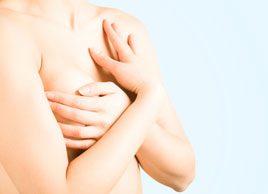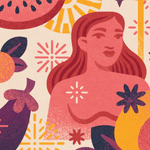Your guide to healthy breasts
Like all our body parts, our breasts can undergo changes as we age. Some of the changes my simply be unwelcome, while others can be worrisome. Here are five of the most common changes, what they mean’and when to get them checked out

Source: Best Health Magazine, October 2009
1. Pain
What’s going on?
More than two thirds of women experience breast pain or tenderness at some point in their lives. Pain from fluid retention is especially common before your period. Having a cyst can also cause pain, as can mastitis, an infection most common in breastfeeding women.
What can you do?
For premenstrual breast pain, try regular exercise, which can reduce fluid retention. Choose a non-jarring activity, such as yoga. Try a low-fat diet, a good support bra and avoiding alcohol or caffeine, and consider taking an evening primrose oil supplement; studies show it can ease pain.
When to see the doc
‘Pain is rarely associated with cancer in the early stages,’ says Dr. Ruth Heisey, a GP with expertise in breast cancer at Toronto’s Princess Margaret Hospital. But if the pain is new, especially if it’s on one side only and persists for a couple of weeks, it should be checked. If your breast is swollen and tender, the skin is red and you have a fever, you might have mastitis and may need an antibiotic.
Uplifting news
Breast biomechanics expert Joanna Scurr, of the University of Portsmouth in the U.K., is working with bra manufacturers to help design sports bras. Scurr says more than half of women who exercise have pain from the movement of their breasts, often even while wearing a sports bra and regardless of breast size. ‘Good support can reduce pain,’ she says.
2. Lumps and bumps
What’s going on?
Finding a breast lump can be terrifying, but most of the time it’s not cancer. Breast lumps can be caused by infection or injury. It’s possible, too, that they are fibroadenomas (non-cancerous lumps of tissue).
Lumps can also be harmless cysts. ‘These are quite common around menopause,’ says Heisey.
About half of all women experience fibrocystic breast changes during the reproductive years. These changes can cause breasts to feel swollen, ropy, lumpy and painful, and are at their worst about seven to 10 days before a period.
What can you do?
If it’s a cyst, your doctor can drain it using a needle and syringe. Cysts may also disappear on their own.
To avoid fibrocystic breasts, try limiting your caffeine, alcohol and salt intake while you’re premenstrual. ‘And try a high-fibre diet with plenty of plant-based foods. It can help reduce the cyclical fluctuation of symptoms,’ advises Natalie Brown, a registered dietitian based in South Surrey, B.C. Some research suggests that vitamin E may also help ease symptoms.
When to see the doc
Any time you feel a lump that doesn’t go away, make an appointment with your doctor. ‘A lump should be assumed to be cancer unless proven otherwise,’ says Heisey.
3. Nipple discharge
What’s going on?
Nipple discharge is the third most frequent breast complaint in women, after pain and lumps. It’s most common in women who have had at least one pregnancy and who have not yet reached menopause. Discharge can be caused by hormonal changes, medications, an abscess, an infection or cysts. It can also happen for a year or two after pregnancy if you are not breastfeeding. Sometimes it is a symptom of a blocked or infected milk duct’again, even if you’re not breastfeeding. Most of the time, it doesn’t indicate cancer.
What can you do?
Avoid squeezing your nipples or letting your partner stimulate them during sex, because this can lead to an increase in discharge. Depending on the underlying cause of the discharge, your doctor may prescribe medication. If the fluid is part of the breast’s normal function, such as with hormonal changes or after pregnancy, it will often go away on its own.
When to see the doc
If you are experiencing any persistent nipple discharge, you should check it out with your physician, especially if it’s from one breast only and happens without squeezing. ‘If you have any associated crusting or bleeding of the nipple, that is concerning,’ Heisey adds. ‘It could be symptomatic of Paget’s disease, which is a rare type
of cancer.’
4. Inverted nipples
What’s going on?
Up to one in 30 women are born with inverted nipples, which means the nipple is pulled inward instead of pointing out. Nipples can become inverted later in life as a result of breast surgery, including biopsy, lumpectomy, cyst removal or plastic surgery, or after an infection. A newly inverted nipple can also be a sign of cancer or mastitis, which is an infection of the breast tissue.
What can you do?
Breastfeeding with inverted nipples can sometimes be a challenge, but having surgery to correct it can make breastfeeding impossible. Nipple shields and moulds can help to draw out the nipple temporarily without surgery, allowing you to breastfeed. Ask your doctor about your options if you are pregnant.
When to see the doc
‘Any new inversion of the nipple should be checked out,’ says Heisey.
5. Change in shape and size
What’s going on?
Extreme exercise, weight gain or loss, pregnancy and menstrual cycles can cause breasts to change in shape and size. About one in five women develop larger breasts after menopause, as fatty tissue builds up.
What can you do?
For sagging, watch your posture. ‘Posture does make a difference to the way your breasts look,’ says Dr. Kevin Smith, a dermatologist in Niagara Falls, Ont. He says there is some evidence that Botox injections may help lift sagging breasts, especially in combination with muscle strengthening. Also, quit smoking and avoid the sun; both make sagging worse by speeding the breakdown of elastin, a protein that helps the skin resist stretching.
In general, invest in a proper-fitting bra and a good sports bra for exercising: These will improve posture and appearance.
When to see the doc
Women should never ignore a change in size or shape. Also, have your breasts assessed if one changes and the other doesn’t, especially if one gets considerably larger. (However, if you have had one breast that is slightly larger than the other from an early age, that is considered normal.) Other important but often overlooked symptoms are skin thickening, redness, dimpling and nipple crusting. All could be signs of cancer.
This article was originally titled "Healthy boobs," in the October 2009 issue of Best Health. Subscribe today to get the full Best Health experience’and never miss an issue!’and make sure to check out what’s new in the latest issue of Best Health.




